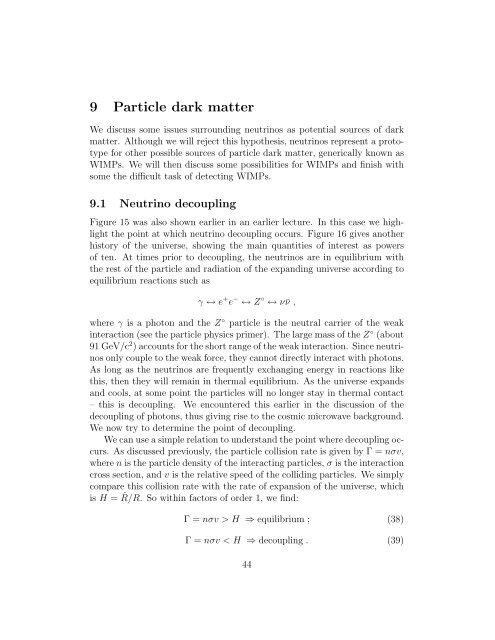Lecture Notes for Astronomy 321, W 2004 1 Stellar Energy ...
Lecture Notes for Astronomy 321, W 2004 1 Stellar Energy ...
Lecture Notes for Astronomy 321, W 2004 1 Stellar Energy ...
You also want an ePaper? Increase the reach of your titles
YUMPU automatically turns print PDFs into web optimized ePapers that Google loves.
9 Particle dark matter<br />
We discuss some issues surrounding neutrinos as potential sources of dark<br />
matter. Although we will reject this hypothesis, neutrinos represent a prototype<br />
<strong>for</strong> other possible sources of particle dark matter, generically known as<br />
WIMPs. We will then discuss some possibilities <strong>for</strong> WIMPs and finish with<br />
some the difficult task of detecting WIMPs.<br />
9.1 Neutrino decoupling<br />
Figure 15 was also shown earlier in an earlier lecture. In this case we highlight<br />
the point at which neutrino decoupling occurs. Figure 16 gives another<br />
history of the universe, showing the main quantities of interest as powers<br />
of ten. At times prior to decoupling, the neutrinos are in equilibrium with<br />
the rest of the particle and radiation of the expanding universe according to<br />
equilibrium reactions such as<br />
γ ↔ e + e − ↔ Z ◦ ↔ ν¯ν ,<br />
where γ is a photon and the Z ◦ particle is the neutral carrier of the weak<br />
interaction (see the particle physics primer). The large mass of the Z ◦ (about<br />
91 GeV/c 2 ) accounts <strong>for</strong> the short range of the weak interaction. Since neutrinos<br />
only couple to the weak <strong>for</strong>ce, they cannot directly interact with photons.<br />
As long as the neutrinos are frequently exchanging energy in reactions like<br />
this, then they will remain in thermal equilibrium. As the universe expands<br />
and cools, at some point the particles will no longer stay in thermal contact<br />
– this is decoupling. We encountered this earlier in the discussion of the<br />
decoupling of photons, thus giving rise to the cosmic microwave background.<br />
We now try to determine the point of decoupling.<br />
We can use a simple relation to understand the point where decoupling occurs.<br />
As discussed previously, the particle collision rate is given by Γ = nσv,<br />
where n is the particle density of the interacting particles, σ is the interaction<br />
cross section, and v is the relative speed of the colliding particles. We simply<br />
compare this collision rate with the rate of expansion of the universe, which<br />
is H = Ṙ/R. So within factors of order 1, we find:<br />
Γ = nσv > H ⇒ equilibrium ; (38)<br />
Γ = nσv < H ⇒ decoupling . (39)<br />
44













